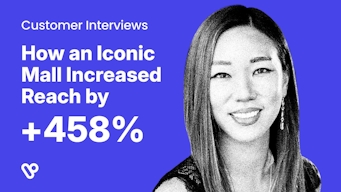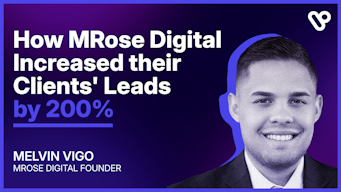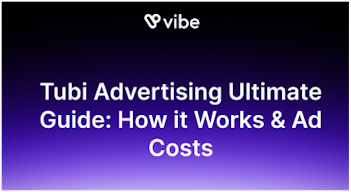SVOD vs AVOD: What is the difference?
Do you need help choosing SVOD or AVOD for your advertising strategy?
Understanding the differences between these models is crucial for aligning with your business goals and maximizing ROI.
In this blog, we’ll cover:
- SVOD vs AVOD Breakdown: Discover what sets these two models apart.
- Key Differences: Explore the pros and cons of each and their impact on your advertising strategy.
- Practical Tips: Get insights on selecting the suitable model to enhance audience engagement.
Choosing the right model can significantly influence your advertising success, saving you time and resources.
Ready to refine your TV advertising approach?
Let’s dive in!
What Is SVOD?
Subscription Video on Demand (SVOD) is a streaming model in which users pay a recurring fee to access content. These platforms operate without ads and offer an uninterrupted viewing experience in exchange for a subscription.
With SVOD, you can :
- Watch exclusive content that you can’t find elsewhere.
- Watch videos ads free.
- Personalized recommendations based on your watch history.
Netflix, Amazon Prime Video, and Disney+ are famous examples of SVOD platforms.
Pros of SVOD
- Loyal audience: Subscribers are highly engaged and valuable for long-term content promotion.
- Quality association: Partnering with SVOD platforms increases brand perception by associating with premium content.
- No interruptions: Ad-free viewing ensures your content isn’t disrupted.
Cons of SVOD
- Limited reach: Subscription costs can exclude broader audiences.
- High costs: Producing or acquiring content for these platforms can be expensive.
What Is AVOD?
Advertising Video on Demand (AVOD) is a free streaming model supported by ads. It allows users to access content without a subscription, with revenue generated through advertising placements.
With AVOD, you can:
- You can see ads tailored to their interests, like fitness ads for fitness enthusiasts.
- You can watch shows and movies for free, with occasional ads.
- You can experience personalized content and ad suggestions based on viewing habits.
Platforms like YouTube, Peacock, and Hulu (with ad-supported plans) operate on the AVOD model.
Pros of AVOD
- Wider reach: Free access attracts a large and diverse audience.
- Cost-effective: Advertising on AVOD platforms is budget-friendly compared to traditional TV ads.
- Precision targeting: Viewer data allows businesses to show ads to specific demographics.
Cons of AVOD
- Ad fatigue: Excessive ads can lead to viewer dissatisfaction.
- Revenue dependency: Success relies on maintaining high viewer numbers for substantial ad revenue.
SVOD vs AVOD: Which Model Is Right for Your Business?
SVOD (Subscription Video On Demand)
Best For:
- Premium Content Creators: Businesses offering exclusive, high-quality content that viewers will pay for.
- Recurring Revenue Seekers: Companies wanting predictable income from subscription fees.
- Niche Markets: Ideal for content targeting specific interests that attract dedicated audiences.
AVOD (Ad-Supported Video On Demand)
Best For:
- Broad Reach: Businesses aiming to attract a wide audience with free access to content.
- Diverse Content Creators: Platforms offering various content types—originals, user-generated, or older shows.
- Ad Monetization Focus: Companies that can leverage targeted advertising to generate revenue through ads.
Here’s a detailed breakdown of SVOD vs AVOD to help you better understand their key differences:
| Features | SVOD (Subscription Video On Demand) | AVOD (Ad-Supported Video On Demand) |
|---|---|---|
| Cost for Viewers | Subscription-based, requiring a monthly/annual fee. | Free to viewers, supported by advertisements. |
| Content Availability | Premium and exclusive content tailored to subscribers. | Variety of ad-supported content for broader reach. |
| Advertising Opportunities | No ads, providing an uninterrupted viewing experience. | Personalized, high-engagement ad placements. |
| Revenue Model | Primarily reliant on subscription fees. | Revenue generated from advertisers. |
| Scalability | Limited to the number of subscribers and retention rates. | Scales effectively with advertiser demand and viewer growth |
Why Should Businesses Consider Programmatic Advertising on AVOD Platforms?
Precision Targeting
- AVOD platforms help you connect with the right audience. You can customize campaigns using advanced analytics based on viewer demographics and preferences.
- Your ads only reach people likely to engage, boosting conversions and saving money.
Cost-Effectiveness
- AVOD lets you advertise within your budget, unlike traditional TV ads with high upfront costs.
- Whether you're a small business or a large corporation, you only pay for the results you get, making it a smart, affordable option.
Scalability & Flexibility
- With AVOD, you can scale your campaigns to reach local or global audiences.
- Flexible formats like pre-roll and skippable ads let you test and optimize for better engagement—without overspending.
Real-Time Optimization
- Programmatic advertising gives you the power to tweak campaigns in real time.
- If an ad isn’t performing, adjust it on the fly to improve results; waiting until the campaign ends is unnecessary.
Broadened Audience Reach
- Since AVOD platforms are free, they draw a diverse audience.
- This allows you to engage new customer segments and boost brand visibility across various demographics.
Why This Matters?
AVOD platforms deliver a powerful blend of precision, scalability, and cost-effectiveness that traditional advertising often can't compete with.
Programmatic advertising on AVOD platforms is great for reaching the right people without spending too much.
But figuring out which tool to use can feel overwhelming.
That’s why we’re talking about Vibe. It’s made to simplify things for businesses, helping you save money, target the right audience, and see how well your ads are doing.
Learning about Vibe is worth your time if you want to advertise smarter, not harder.
How Does Vibe Stand Out in the Advertising Ecosystem?
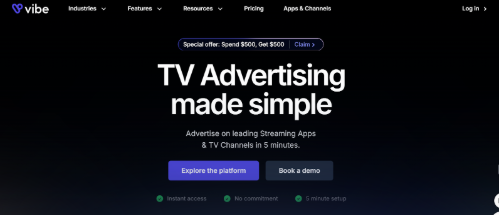
Regarding programmatic advertising, Vibe is redefining the CTV (Connected TV) business with its data-driven approach, automation, and user-centric features.
Here’s what makes Vibe a better choice for brands:
Programmatic Excellence on AVOD Platforms
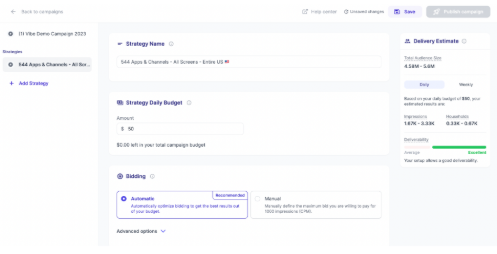
- Automated Ad Placements: Vibe leverages programmatic technology to automate ad placements across over 500 streaming channels, including sports, movies, and local news.
- Data-Driven Decisions: Vibe analyzes real-time data to ensure ads reach the right audience at the right time, removing guesswork and manual setup.
Advanced Targeting Capabilities
- Precision at Scale: Target audiences based on location, demographics, interests, or purchase intent.
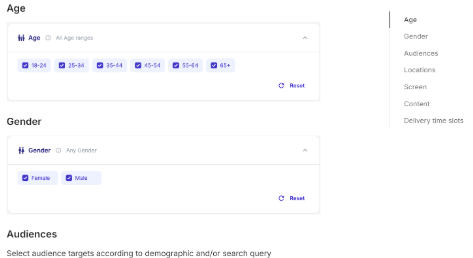
- Broad Channel Access: From local markets to national audiences, Vibe connects brands with diverse viewers across popular AVOD and OTT platforms.
Transparent Pricing
- Budget-Friendly Options: Pricing starts at just $500, with CPM rates between $15–$35.
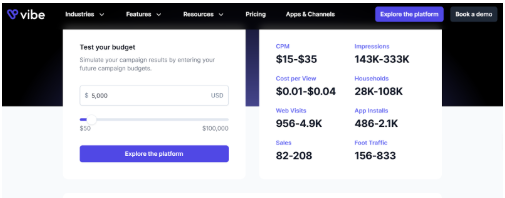
- No Surprises: Vibe provides upfront estimates for impressions, views, and conversions, eliminating hidden fees.
Real-Time Performance Tracking
- Monitor Campaign Success: Access real-time conversions, impressions, and audience engagement insights.
- Optimize on the Fly: Adjust your campaigns mid-flight with actionable data to improve results.
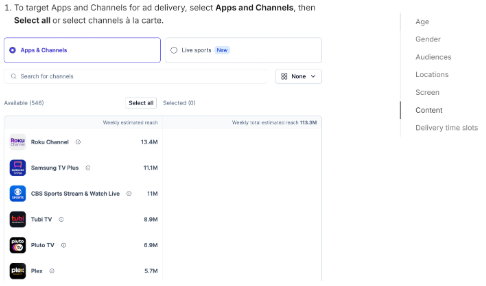
Simplified Ad Management With AI
- AI-Driven Assistance: Vibe AI Assistant recommends ideal channels and targeting strategies for your campaigns.
- Creative Made Simple: With Vibe Studio, produce high-quality TV ads in seconds—even without prior experience.
Why Choose Vibe?
Vibe isn’t just a platform—it is designed for brands looking to harness the power of CTV advertising. With automation, precision targeting, transparent pricing, and intuitive tools, Vibe helps businesses maximize ROI and achieve meaningful campaign results.
Conclusion
Choosing between SVOD and AVOD can significantly influence your business strategy in the TV landscape.
Here’s a quick summary:
Key Takeaways
- SVOD: Premium, ad-free experience for paying audiences, fostering more profound connections.
- AVOD: Free access with targeted ads, ideal for expanding reach and monetizing larger audiences.
When to Choose
- SVOD: Best for brands valuing premium engagement and exclusivity.
- AVOD: Ideal for businesses looking to grow their audience and generate ad revenue.
No matter which you choose, platforms like Vibe can optimize your campaigns with advanced programmatic tools, automate ad placements, and leverage real-time data.
Elevate your advertising efforts with Vibe and thrive in programmatic TV advertising!

